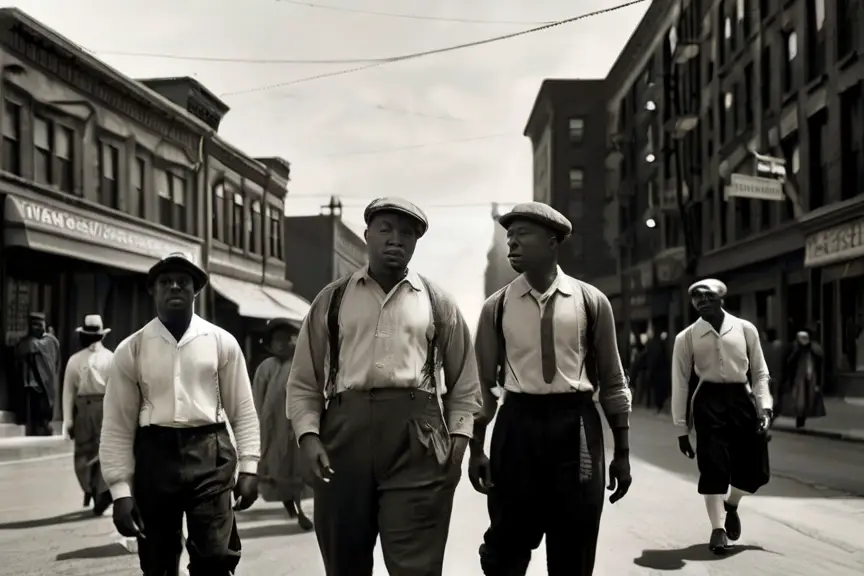
The Harlem Renaissance was a cultural, social, and artistic explosion that took place in the 1920s and 1930s in Harlem, New York City.
This period was marked by the flourishing of African American art, literature, music, and intellectual thought.
In this blog post, we will delve into the daily life of the Harlem Renaissance, focusing on the working class and middle class/intellectuals, the power of expression, and the challenges faced during this time.
Harlem Renaissance Daily Life
The Harlem Renaissance was a time of great change and progress for African Americans.
Daily life during this period was shaped by various factors, including the Great Migration, the rise of African American middle class, and the flourishing of African American culture.
- Read also: Exploring the Legacy: Famous Harlem Renaissance Poets
- Read also: The Legacy: Famous Renaissance Poets Who Shaped Literature
A Day in the Life (Working Class)
During the Harlem Renaissance era, life for the working class in Harlem was marked by strenuous labor, low wages, and tough living conditions.
Many African Americans worked in factories, as domestic servants, or as street vendors to support themselves.
Their days began early, with each person preparing for their job, whether in a factory, a household, or on the streets of Harlem.
Throughout the day, they worked hard despite difficult conditions and little pay.
Factory workers endured noisy machinery, domestic workers navigated complex household dynamics, and street vendors hustled to sell their goods.
At day’s end, the working class returned home tired but resilient, having played a vital role in laying the groundwork for the cultural renaissance of the time.
A Day in the Life (Middle Class/Intellectuals)
During the Harlem Renaissance, the middle class and intellectuals lived in a world of privilege and cultural refinement.
Their mornings began with a sense of purpose and curiosity, dedicating themselves to their fields of study or profession.
Throughout the day, they immersed themselves in scholarly pursuits, artistic creation, and social engagements.
Libraries and lecture halls were their sanctuaries, where they explored literature, philosophy, and academic discourse.
Social interactions were crucial, fostering a culture of intellectual exchange and collaboration.
Evenings were dedicated to creative endeavors, with writers, musicians, and artists producing their works.
Their contributions shaped the cultural landscape of the era, leaving a lasting impact on history.

The Power of Expression
The Harlem Renaissance was a period of significant cultural and artistic expression, defined by the rise of African American art, literature, music, and intellectual thought.
Literature
The literature of the Harlem Renaissance helped to instill a strong sense of pride, defiance, and confidence in African Americans.
It encouraged resistance to racism and challenged stereotypes, and it also reminded African Americans of their roots and the difficulties they had already overcome.
Writers like Claude McKay, Langston Hughes, and Zora Neale Hurston used their works to express the experiences and emotions of the African American community during this time.
Music
Jazz, blues, and the theater were significant forms of expression during the Harlem Renaissance.
New Orleans native Louis Armstrong introduced an early form of jazz, which reflected the characteristics and issues of the era, and helped build a connection between African American culture and the rest of American society.
Bessie Smith, known as the Empress of the Blues, sang of unfulfilled love, poverty, and oppression, giving voice to the difficult social and economic position of African Americans during this time.
Intellectual thought
Intellectuals like W.E.B. Du Bois, Marcus Garvey, Cyril Briggs, and Walter Francis White played a crucial role in shaping the intellectual landscape of the Harlem Renaissance.
They promoted the artistic minds of the Renaissance in their writings and pushed artists to depict racial equality in their works.
Their ideas and writings helped to invigorate black intellectual leadership, strengthen blacks’ group consciousness, and embolden black political activism.

The challenges
While it brought about many positive changes, it also presented several challenges for those living in Harlem during this time.
Here are some of the main challenges faced by the community:
Economic challenges
The Harlem Renaissance was a time of significant economic change for African Americans.
Many migrated from the South to the North in search of better opportunities, and Harlem became a hub for African American culture and intellectual thought.
Social challenges
Despite the cultural and artistic achievements of the Harlem Renaissance, African Americans still faced significant social challenges.
Racism and discrimination were prevalent, and many African Americans continued to face economic and social hardships.
The Great Depression, which began in 1929, further exacerbated these challenges, leading to increased poverty and unemployment.
Political challenges
The Harlem Renaissance was also a time of political awakening for African Americans.
Activists like Marcus Garvey and W.E.B. Du Bois encouraged a sense of Black excellence, pride, and shared identity, which became known as the “New Negro” movement.
This movement sought to challenge racial stereotypes and fight for civil rights through organizations like the Universal Negro Improvement Association and the African Communities League.
Cultural challenges
The Harlem Renaissance was a time of cultural experimentation and expression, but it also presented challenges for the community.
Some African Americans felt that the movement was too focused on the middle class and did not adequately represent the experiences of less privileged members of the race.

- Read also: Contrasting Worlds: Renaissance Art Vs. Medieval Art
- Read also: Reviving the Essence: Exploring English Renaissance Poets
Conclusion
The Harlem Renaissance was a pivotal period in African American history, marked by the flourishing of African American art, literature, music, and intellectual thought.
Daily life during this time was shaped by various factors, including the Great Migration, the rise of the African American middle class, and the challenges faced by the community.
Despite these challenges, the Harlem Renaissance remains a testament to the resilience and creativity of the African American community.
FAQs
The Harlem Renaissance was influenced by the Great Migration, the rise of the African American middle class, and the flourishing of African American culture.
Some of the most influential figures of the Harlem Renaissance include Langston Hughes, Zora Neale Hurston, and Duke Ellington.
The Harlem Renaissance had a significant impact on African American culture by promoting the works of African American artists and intellectuals and celebrating the African American experience.

